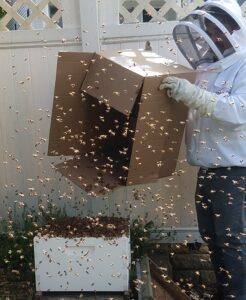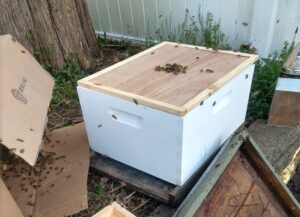Last spring we started raising bees. Because of the pandemic, our local beekeeper’s group (PCBA) didn’t their regular “Bee School,” so Beth and I muddled through on our own, courtesy of a “dummies guide” book, and lots of YouTube videos. We did okay. One of our two hives died out before winter, but the other not only made it through fine, but produced about 17 pounds of honey. (I never realized that honey is sold by weight, not volume.)
Bee school started and finished, and we got a package to replace the dead hive. It’s not unusual: many “beeks,” or beekeepers, have significant losses over the winter. The new bees (sorry not sorry) seem to be doing well.
Yesterday, when we came back from errands, my neighbor grabbed me to say that my bees had escaped into a tree on his front yard:

Swarms happen when the population gets too big for the space. The old queen flies off with a good portion of the population, and looks for a new home. It’s common for beekeeper’s to “capture” the swarm and bring it back. They are often also on call, like a volunteer “animal insect control officer,” for when someone finds a swarm to come and safely remove it.
I donned my suit and the neighbors came to watch. Armed with a branch-trimming pole, I shook the cluster, and the bees fell into the box I had placed underneath. A few more shakes and I was sure that the queen was in the box. Waiting for several minutes, the bees followed her.

I brought the box to the backyard and shook the bees into a new hive box. After some buzzing around, the queen was inside and the rest of the bees calmed down and followed her in:


Once they had crawled down into the hive, I could put an interior lid, a “queen excluder” to keep her from crawling out and flying away, and a lid. You can see the lid in the lower-right corner of the picture. The box of bees on the left slowly emptied out as they crawled into the hive.

This was done yesterday around dusk. This morning, they’re happily buzzing next to their old location, and completely forgetting that the hive right next to them used to be their home.